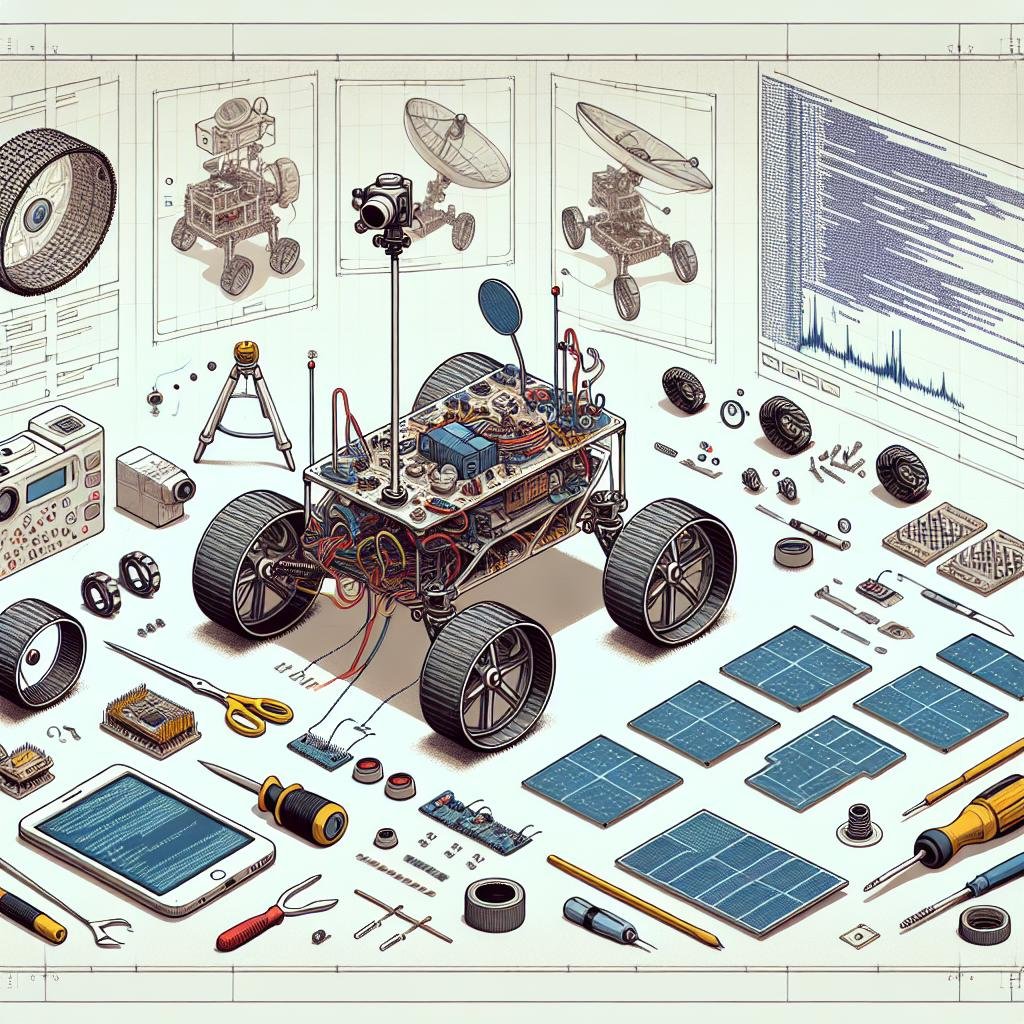In an era where technology seamlessly intersects with creativity, the allure of do-it-yourself (DIY) robotics projects has captured the imagination of hobbyists and tech enthusiasts alike. Whether you’re a seasoned inventor or a curious beginner, the world of DIY robotics offers a playground of possibilities that extend far beyond ordinary weekend activities. This article embarks on an exploratory journey to uncover the most popular and captivating DIY robotics projects that inspire innovation and ignite the spark of ingenuity. From simple, educational builds to more complex autonomous creations, these projects promise not only to challenge your skills but also to provide a fulfilling and enlightening experience. Let’s delve into the fascinating realm where circuits meet coding and hands-on craftsmanship fuels the future of robotics.
Building Your First Autonomous Rover
Dive into the world of robotics by ! This project is not only exciting but also educational, providing a hands-on approach to understanding essential concepts like motor control, sensor integration, and basic programming. Start with a simple chassis, which can be a pre-made kit or a DIY design. Equip your rover with DC motors for movement and a microcontroller like Arduino or Raspberry Pi for brainpower. Sensors such as ultrasonic or infrared will enable your rover to navigate its environment autonomously, avoiding obstacles and making decisions based on real-time data.
A key aspect of building an autonomous rover is the software. Write code that instructs your rover to explore its surroundings, detect objects, and change direction when necessary. Many hobbyists use Python for its simplicity and powerful libraries. Additionally, enhance your rover’s functionality by adding camera modules for visual detection, or even GPS units for location tracking. The following table summarizes the recommended components for a beginner-friendly autonomous rover:
| Component | Description |
|---|---|
| Chassis | Base structure or kit for the rover |
| DC Motors | For driving wheels |
| Microcontroller | Arduino or Raspberry Pi |
| Sensors | Ultrasonic or infrared |
| Power Supply | Battery pack |
| Programming | Python or C++ |

Harnessing the Power of Robotic Arms
Robotic arms are revolutionizing home workshops and makerspaces, enabling hobbyists to bring professional-level precision and functionality to their DIY projects. These versatile tools can be programmed for a variety of tasks, from soldering and 3D printing to painting and assembling intricate models. By leveraging open-source platforms and affordable kits, enthusiasts can create custom robotic arms tailored to their specific needs and skills. Imagine a robotic arm painting a masterpiece or assisting in assembling intricate drone components—the possibilities are endless!
For those wanting to dive into robotics, there are numerous popular DIY robotic arm projects. Here are a few ideas:
- 3D Printed Robotic Arm: Create a robust arm using 3D printing for both the structure and joints.
- Arduino-Controlled Arm: Utilize Arduino boards for smart and versatile control mechanisms.
- Multi-Functional Arm: Build an arm that can switch between tools like a drill, a screwdriver, and a claw.
| Project | Key Components |
|---|---|
| 3D Printed Arm | 3D Printer, PLA Filament, Stepper Motors |
| Arduino Arm | Arduino Uno, Servo Motors, Breadboard |
| Multi-Functional Arm | Interchangeable Tools, Motor Shield, Control Software |

Mastering Home Automation with DIY Robots
Imagine walking into your home, and with a simple voice command, the lights adjust to your preferred ambiance, the thermostat sets to the perfect temperature, and your favorite music starts playing. This futuristic vision can become a reality with DIY robotics projects that integrate with smart home technology. Enthusiasts can start with something simple like smart light automation using Arduino or Raspberry Pi. These platforms allow you to control household lights from your smartphone or through voice commands with virtual assistants like Alexa or Google Assistant.
For those who are a bit more adventurous, building a DIY robot vacuum or a robotic lawnmower could be incredibly rewarding. These projects might require a basic understanding of mechanical design, sensors, and coding but the results are worth it. Not only do these projects bring convenience, but they also offer endless customization possibilities. Here’s a quick comparison of popular DIY home automation robotics projects:
| Project | Complexity | Required Skills |
|---|---|---|
| Smart Light Automation | Beginner | Coding, Basic Electronics |
| DIY Robot Vacuum | Intermediate | Mechanical Design, Sensors, Coding |
| Robotic Lawn Mower | Advanced | Mechanical Engineering, Advanced Coding |

Educational Robots for Aspiring Coders and Engineers
Embracing the thrill of hands-on learning, aspiring coders and engineers can dive into the world of DIY robotics with an array of exciting projects. Whether you’re a student, hobbyist, or educator nurturing young minds, these projects offer a perfect blend of creativity and technical skill development. Some popular choices include:
- Line Following Robots: A foundation project for many, harnessing the power of sensors and simple algorithms to track and follow paths on a map.
- Obstacle Avoidance Robots: Utilizing ultrasonic sensors, these robots teach the fundamentals of autonomous movement and environment monitoring.
- Robotic Arms: Offering insights into the mechanics of movement, these projects integrate motors and software to simulate human arm functions.
- Walking Robots: From bipedal to quadrupedal designs, these projects highlight principles of balance and coordination.
For those looking to take their projects up a notch, adding intricate programming challenges and complex designs can lead to even more educational benefits. Here’s a quick overview of advanced projects:
| Project | Key Learning Points |
|---|---|
| Remote-Controlled Cars | Coding for navigation, integrating Bluetooth/wireless modules. |
| AI-Powered Robots | Machine learning basics, implementing voice/image recognition. |
| Drones | Aerodynamics, GPS navigation, advanced circuitry. |
Q&A
Q: What is the main focus of the article “The Most Popular DIY Robotics Projects to Try”?
A: The article provides a detailed exploration of the trending DIY robotics projects that enthusiasts of all skill levels can undertake. It highlights a variety of projects, ranging from beginner-friendly to more advanced builds, all aimed at nurturing creativity and technical skills.
Q: Can beginners find suitable projects within this article?
A: Absolutely! The article includes a selection of projects specifically tailored for beginners. These projects are designed to introduce newcomers to the basics of robotics, utilizing simple components and straightforward instructions.
Q: What are some examples of beginner-friendly projects mentioned?
A: Among the beginner-friendly projects, the article features a line-following robot and a simple obstacle-avoiding robot. Both projects provide a hands-on introduction to basic robotics principles and programming.
Q: Does the article cater to advanced hobbyists as well?
A: Yes, the article includes projects that challenge even experienced hobbyists. Advanced projects involve more complex builds, such as a robotic arm, a drone, and an autonomous vehicle, requiring a deeper understanding of programming, electronics, and mechanical design.
Q: What materials and tools are commonly needed for these DIY robotics projects?
A: Common materials and tools highlighted include microcontrollers (like Arduino and Raspberry Pi), sensors, motors, wires, and basic hand tools like screwdrivers and pliers. Each project description lists specific materials and tools required, ensuring readers can prepare adequately.
Q: Are there any educational benefits to engaging in these DIY robotics projects?
A: Yes, the article emphasizes the educational advantages of tackling DIY robotics projects. These projects enhance problem-solving skills, foster creativity, and provide practical experience in coding and electronics. They also encourage perseverance and critical thinking.
Q: How does the article recommend sourcing parts for these projects?
A: The article suggests several approaches for sourcing parts, including online retailers, local electronics stores, and repurposing components from old gadgets. It also provides tips on finding affordable and high-quality materials to keep costs manageable.
Q: Are there any safety tips or precautions mentioned for these projects?
A: Safety is a key consideration in the article. It underscores the importance of working in a well-ventilated area, wearing protective gear like safety goggles, and double-checking connections to avoid short circuits. Proper handling of tools and components is also stressed to prevent accidents.
Q: Does the article provide any online resources or communities for additional help and support?
A: Yes, the article lists several online platforms and communities where DIY robotic enthusiasts can seek advice, share their progress, and collaborate with others. Websites like Instructables, GitHub, and various robotics forums are recommended for further learning and troubleshooting.
To Wrap It Up
As the gears of curiosity turn and the circuits of creativity light up, the world of DIY robotics opens a universe of endless possibilities. Each project you’ve explored is more than just a creation; it’s a testament to human ingenuity and the boundless potential that lies within your fingertips. So gather your tools, ignite your passion, and let the symphony of motors and microcontrollers guide your journey. Whether you’re a seasoned maker or a curious beginner, remember: in the vast realm of robotics, every bot is a story waiting to be told, and every innovation is a step towards the extraordinary. Keep building, keep dreaming—your next robotic marvel is waiting.

